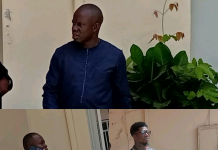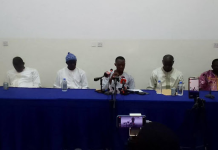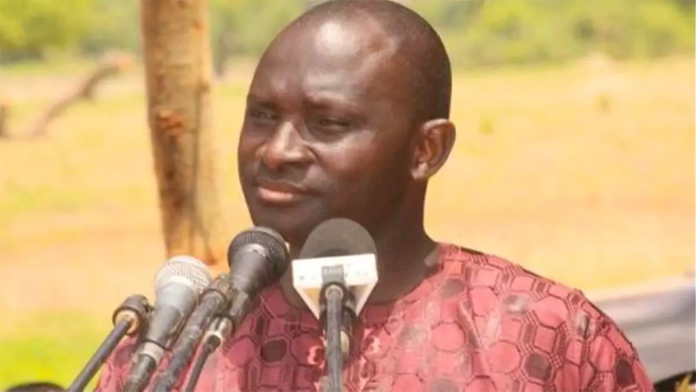Source Trial International: Reported by Kemeseng Sanneh (Kexx)
Ousman Sonko is accused of deprivation of liberty, torture and cruel detention conditions of protesters in April 2016 onwards as crimes against humanity.
Ousman Sonko is being accused, in complicity with a group of perpetrators, of having tortured several political opponents and illegally deprived them of their liberty in the context of a political demonstration organized in April 2016 in Banjul. Within this context, Ousman Sonko is in particular suspected of having tortured and then killed one of the organizers of the demonstration.
Procedural highlight: The Court accepted the Gambian newspaper articles regarding the execution of nine inmates in 2012 as evidence to be added to the case file.
Ousman Sonko was called to testify on the 14 April 2016 event. The accused (Ousman Sonko) denied having been present at the Police Intervention Unit’s headquarters (PIU HQ) recalling that some people stated that they did not see him there. While he was not on site on the 14th, he was indeed there on 16 April 2016.
“For this reason, some people might have confused the incidents,” Sonko said.
He added that he did not take part in the investigation panel at the NIA. Ousman Sonko then reiterated that the command and the structure of the Junglers were not under his supervision.
He was then confronted with written notes – found by the police – in a suitcase seized from where he had been arrested in 2017. The notes, among other things, say the following: “(…) during the April 14 & 16 incident ‘he gave me instructions for the police to shoot and kill the opposition (…) took over the PIU’.
The accused contested having had any document in the suitcase but confirmed it was his handwriting. He explained that the first part of the events mentioned in this note never happened and that the second part took place, however at a later time.
· The second note said: “Directive to harass (…) and even to assassinate and not to issue permit for (…) I refused. (…) did not go well with him (…); Ordered me to instruct the police to shoot and kill the Apr. 14 & 16 demonstrators, and I refused; Give a directive for those arrested by the police to be handed over to the NIA, which I did. They were handed over to the NIA, which reports directly to him. At the NIA, these people would be (were) tortured by the president spec paramilitary forces called the black black or Junglers. The Junglers respond directly to the president. Those supporters of the UDP were severely tortured [resulting in the death of Solo SANDENG and others were severely wounded)”
Ousman Sonko explained that it was not what transpired, he wrote this note to support his asylum request.
Further, Ousman Sonko stated that it was not true to say that protesters were arrested in April 2016 because of their political opposition but the demonstration had taken place illegally. He added, “The arrests had hence nothing to do with a breach of their political rights or their freedom of association but were a security matter”.
· With regards to detention conditions in Mile 2, while he recognized that they were not the best, he repeated that he did everything in his power to improve them during his term at the Ministry. According to the law, it was not his role to visit detention places, but it was the prisons’ directors. As Minister, he said he had no operational duty and it was not his role to control David Colley (former Director General of prisons, DGP). Likewise, the decision to transfer detainees from one place of detention to another was under the DGP’s responsibility.
Procedural highlight: At the hearing’s resumption, the plaintiff’s lawyer filed additional material related to the March 2006 events (archived Gambian newspaper articles), a video of June 2016 showing Ousman Sonko addressing publicly a crowd as well as, inter alia, an Amnesty International letter confirming the list of reports that were released about the Gambian human rights situation under Yahya Jammeh and the numerous calls for “urgent actions” released by the Organization – where Ousman Sonko was suggested as a recipient as Minister of Interior, was discussed.
The federal Prosecutor supported the requests to include this additional material in the case file, arguing that it demonstrates the elements of an attack against the civilian population and particularly the attack against journalists. The defence deferred to the Court’s decision as to whether or not to accept the documents.
After a short break, the Court accepted the material and other complementary reports as evidence to be added to the file, confirming that prima facie has been made, and they are likely to provide additional information for the judges to decide on the existence of an attack against the population which is an element of the crime against humanity.
The accused’s hearing then resumed. The Prosecutor confronted Ousman Sonko to the fact that he for the first time in the proceedings had just admitted that he had been the one writing the notes. He answered that the documents in question were not in his suitcase, that he was not present when the documentation was seized and that the police were best placed to answer where these documents had been found.
He did not admit that it was his handwriting during the investigation because he was exercising his right to remain silent and because he wanted to tell it to the Court. He refused to answer the question as to why, according to his recent statement, the notes were only partially reflecting the truth. He was then confronted with the fact that the only part where he said the notes did not true correspond with the findings of the TRRC, with the declarations of the plaintiffs, as well as with the results of the Prosecutor’s investigation. He answered that there was nothing concrete and that everything was vague.
·
· The Truth Reconciliation and Reconciliation Commission (TRRC) process was not a criminal proceeding where the witnesses’ testimonies would have been cross-examined. As a result, it could not be concluded that the final report of the TRRC reflects the reality.
·
· Ousman Sonko repeated that the arrests in April 2016 were lawful and that there had been no offence perpetrated at the PIU. He said he was particularly not aware of any sexual assault that would have taken place there. He apologized for any inconvenience that might have been caused to the plaintiffs about their detention conditions. It was not the result of a deliberate policy and it was nothing personal, he added. He said he tried his best to improve the prison conditions.
He said the DGP had operational and administrative control over detention places. He then asked where it was written anywhere that the Minister of Interior must control the DGP.
Confronted with section 92 of the Gambian Prisons Act – allowing the Minister of Interior to make rules about prison management – he explained that this power to make rules was fundamentally different from operational and administrative tasks. He added he had no recollection of any report informing him that an inmate was not medically fit for prison (in reference to rule 13 of the subsidiary legislation of the Prisons Act).
·
· Amongst other statements, Ousman Sonko confirmed that the Ministry of Interior was a member of the Prison visiting committee, as file documents indicated. However, he was not the one representing the Ministry during these visits, he told the Court. He testified he did not see any letter that would have been sent to him within the frame of Amnesty International’s urgent calls.
·
· Confronted with a Foroyaa article published in August 2012 titled “Ministry of Interior Statement on the Executions” which says: “The General Public is hereby warned that the rule of law as regards the peace and stability and the protection of lives, property and liberty will not be compromised for whatever reason,”.
Ousman Sonko asked what the problem with such a statement was. According to him, the recently filed press releases from February to May 2015 highlighting numerous arrests and illegal detentions were a demonstration that the press was free.
He repeated that the NIA were never under his de facto or de jure control and that, as a result, he could not have taken any measure towards the Agency following the death of Solo Sandeng in April 2016. Likewise, it was not up to him to take measures regarding the individuals arrested on 14 April 2016, but to those under whose custody they were.
·
· Questioned about the TRRC findings according to which Yahya Jammeh made public statements against Mandinkas such as: “I will wipe them out and nothing will come out of it” and that he would “kill the Mandinkas one by and place them where even a fly couldn’t find them” and also regarding a statement he had himself made while on a so-called Dialogue with the people Tour with the President in June 2016, stating that: “any demonstration would be banned and that all those who would demonstrate would regret this,”.
·
· Ousman Sonko argued that this statement needed to be put back in context and that his words were not the cause of what had taken place on 14 April 2016, rather they had been a reaction to what had happened as a result of an unauthorized demonstration in 2000. Because similar protests had led to deaths and damages in the past (reference made to the April 2000 demonstration), he did not want such events to happen again. By saying this, he wanted to prevent future unauthorized demonstrations.
Upon his lawyer’s questions, Ousman Sonko explained that in the event of protests, where demonstrators would refuse to disperse, arrests could take place. He said in April 2016, the protest leader knew that it was illegal and the police at Westfield intervened in accordance with the law.
Ousman Sonko further explained that he has always advocated against torture and he made efforts so that his subordinates would not resort to it. He said he heard that torture was used at the NIA when he was Minister of Interior, but he did not receive any details. As Minister, he was not empowered to take disciplinary measures against security forces and the police were not in a position to prevent torture from taking place at the NIA.
·
· Regarding the written note discussed earlier, the accused reiterated that he was never ordered to shoot the protesters and would not have followed such an order. He added he did not participate in any Cabinet discussion during which an attack against the population would have been discussed. He also repeated that, as Minister, he did everything in his power to improve the prison conditions.

















